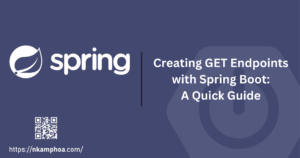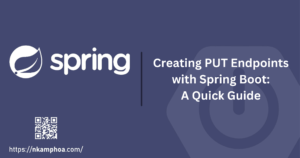Overview
Creating resources is at the heart of RESTful API design. In this article, you’ll learn how to implement a REST API POST endpoint in Spring Boot to handle data submission, validate incoming requests, and return appropriate responses. We’ll also explore best practices to ensure your API remains robust and secure.
This is the second installment in a four-part series on implementing REST web services with Spring Boot. It focuses specifically on POST endpoints. The other articles deal with other types of endpoints, more specifically, GET, PUT, and DELETE endpoints.
Version check
This tutorial has been tested with the following tools :
- Java 17
- Spring Boot 3.2.1
About the project
We assume we have a product entity with the following attributes: id, name, and price. The task is to implement a REST endpoint allowing us to add a new Product to the product database. If successful, a return HTTP status code 201 (CREATED) must be returned along with the new product added. For the sake of simplicity, all our data will be stored in memory. The project will be implemented using the Repository pattern (Controller – Service – Repository). We’ll not spend much time on the Service and Repository layers, but rather on the Controller layer. Let’s start!
Step 1: Generate a template project.
We’ll use Spring initializr to generate the skeleton of our project. Navigate to Spring initializr website and select the following options:
- Project: Maven
- Language: Java
- Spring Boot: 3.2.1
Complete the project metadata section as shown in the image below :
Once everything is filled up, generate the project and import it into your favorite IDE.
Step 2: Create the repository layer
Because we want to keep this tutorial fairly simplistic, we won’t be using a DTO. Create a Product class with the snippet code below.
package com.kloudly.springbootrest.dao;
public class Product {
private Long id;
private String name;
private Double price;
public Long getId() {
return id;
}
public void setId(Long id) {
this.id = id;
}
public String getName() {
return name;
}
public void setName(String name) {
this.name = name;
}
public Double getPrice() {
return price;
}
public void setPrice(Double price) {
this.price = price;
}
}
Create a ProductRepository class with the code below.
package com.kloudly.springbootrest.dao;
import org.springframework.stereotype.Service;
import java.util.ArrayList;
import java.util.List;
import java.util.stream.Collectors;
@Service
public class ProductRepository {
private List<Product> products;
public ProductRepository(){
this.products = buildFakeProducts();
}
private List<Product> buildFakeProducts(){
Product p1 = new Product();
p1.setId(1L);
p1.setName("Leaf Rake");
p1.setPrice(20.12);
Product p2 = new Product();
p2.setId(2L);
p2.setName("Garden Cart");
p2.setPrice(40.99);
Product p3 = new Product();
p3.setId(3L);
p3.setName("Hammer");
p3.setPrice(7.98);
Product p4 = new Product();
p4.setId(5L);
p4.setName("Saw");
p4.setPrice(14.56);
Product p5 = new Product();
p5.setId(6L);
p5.setName("Video Game Controller");
p5.setPrice(39.94);
List<Product> fakeProducts = new ArrayList<>();
fakeProducts.add(p1);
fakeProducts.add(p2);
fakeProducts.add(p3);
fakeProducts.add(p4);
fakeProducts.add(p5);
return fakeProducts;
}
public Product add(Product product){
Long maxId = findMaxId();
product.setId(maxId + 1);
this.products.add(product);
return product;
}
private Long findMaxId() {
return this.products.stream().map(Product::getId).reduce(Long::max).orElse(0L);
}
}
Explanation: Since we are focusing in this tutorial on the Controller layer, the repository layer is managed by in-memory data (ArrayList). To add a new product, we simply find the max of existing products ID and set it to the product to be added. Some fake products are injected into the constructor for testing purposes.
Step 3: Create the service layer.
Create a ProductService class with the code below.
package com.kloudly.springbootrest.services;
import com.kloudly.springbootrest.dao.Product;
import com.kloudly.springbootrest.dao.ProductRepository;
import org.springframework.beans.factory.annotation.Autowired;
import org.springframework.stereotype.Service;
@Service
public class ProductService {
@Autowired
private ProductRepository productRepository;
public Product add(Product product){
return this.productRepository.add(product);
}
}
The service layer is straightforward, just delegating calls to the repository layer with no additional work.
Step 4: Create the controller layer.
Start by creating a simple ProductController class.
RestController
Add @Restcontroller on top of the class to turn it into a RESTful controller.
Add @RequestMapping to provide a base path for your endpoints. Note that any URI you specify here applies to all the methods within the class. Let’s use “/products” as our URI.
Add new Product Endpoint
Create a method named add in your class, taking a Product object as parameter. Annotate your parameter with @RequestBody : add(@RequestBody Product product)
Add the @PostMapping annotation to make it listen to POST calls. This annotation can accept many parameters among which we have “produces”. This parameter accepts a string representing the Mime type. It’s important to know that by default Spring Boot will produce an output in JSON format. Just to simplify the understanding, let’s use the parameter anyway: @PostMapping(produces = "application/json")
Finally, we use ResponseEntity to customize the status code. ResponseEntity in Spring Framework is a Generic Class which represents the whole HTTP response. It can be used to customize the HTTP Status Code, the header, and the body. We’ll be using it here to customize the Status Code of the response.
Here is the full code of our ProductController class.
package com.kloudly.springbootrest.controllers;
import com.kloudly.springbootrest.dao.Product;
import com.kloudly.springbootrest.services.ProductService;
import org.springframework.beans.factory.annotation.Autowired;
import org.springframework.http.HttpStatus;
import org.springframework.http.ResponseEntity;
import org.springframework.web.bind.annotation.PostMapping;
import org.springframework.web.bind.annotation.RequestMapping;
import org.springframework.web.bind.annotation.RestController;
@RestController
@RequestMapping("/products")
public class ProductController {
@Autowired
private ProductService productService;
@PostMapping(produces = "application/json")
public ResponseEntity<Product> add(@RequestBody Product product){
Product addedProduct = this.productService.add(product);
return new ResponseEntity<>(addedProduct, HttpStatus.CREATED);
}
}
Testing
We are using Postman for this example, but you may use any other API testing tool that suits your needs.
Add a new Product
Retrieve all products
Conclusion
In this quick tutorial, we’ve seen how to build a REST API POST endpoint that produces JSON and returns a custom HTTP Status Code. In the next articles, we shall be focusing on other endpoint types: GET, PUT, and DELETE.
You can find the complete code of this article here in GitHub





Wow, I’ve been struggling with creating RESTful POST endpoints in Spring Boot, but this guide just made everything click for me! The explanations are concise yet comprehensive, and the examples really drove the concepts home. Kudos to the author for such a well-written tutorial!c